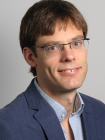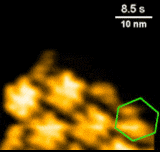Virus assembly has been filmed
Scientists in Groningen and Madrid have managed to capture unique images of the first steps of virus assembly. By using a very fast scanning probe microscope, they were able to film how HIV proteins begin to form a virus. It appears that the virus forming process does not proceed in a very orderly manner. At first sight, it seems very haphazard. Still, this process eventually leads to a regular virus particle. By figuring out how virus assembly takes place, research can be done in a more focused manner into anti-viral medicines that specifically hinder the forming of the virus.
Human immunodeficiency virus (HIV) causes AIDS, a disease that still results in the deaths of over half a million people per year. HIV packages viral genetic material into a capsule containing virus proteins, among other things. While highly clear images have been taken with an electron microscope that show how the proteins are bound to one another, until recently, no methods have been able to demonstrate how they bind together. After all, electron microscopes cannot capture moving images. However, a very fast atomic force microscope recently entered the market: the High Speed Atomic Force Microscope (HS-AFM), with which videos can be made. This microscope has made it possible to study molecular processes by touch , but scientists had not yet succeeded in following the incredibly dynamic process of virus assembly.

Through intensive collaboration between a research group specializing in HIV at the Universidad Autónoma de Madrid and the Molecular Biophysics research group led by Prof. Wouter Roos at the University of Groningen, who have a version of the high-speed microscope in their lab, it became possible to follow virus assembly in real time. ‘A technical masterpiece’, exclaims Prof. Wouter Roos.
Completing the puzzle
The researchers demonstrated that virus assembly does not proceed in a very ordered manner at all. It appears more like completing a jigsaw puzzle, in which puzzle pieces are added at different spots but also taken away again if they do not appear to fit. In this way, the process seems like an apparently haphazard coming and going of proteins, with some sort logic hidden beneath this. Finally, an ordered grid of proteins is created, which forms the basis of the virus particle. It is likely that other viruses use a similar process to build virus particles.
Coronavirus

The results of the research have been published in scientific journal ACS Nano. Now that it is clear how the first stages of virus forming take place, the researchers from Groningen and Spain want to shed light on the next steps. In this way, they hope to create a complete image of the process, from the creation of the individual building blocks at the start, to the formation of a whole infectious virus particle. As well as providing fundamental insights into the biology of viruses, this work also has functional applications. Once it is clear how virus particles are made up, highly targeted research can then be done into anti-viral medicines that focus on interrupting the assembly of the AIDS virus. At a later stage, it is also hoped that these methods can be used to investigate other viruses, such as the coronavirus strain that caused the outbreak of COVID-19.
| Last modified: | 07 August 2020 3.20 p.m. |
More news
-
13 May 2024
‘The colourful cells of petals never get boring!’
Most people will enjoy colours in nature. However, the interest of evolutionary biologist Casper van der Kooi goes much further: he studies how flowers, birds, butterflies, and beetles get their colours. He also studies how these colours are used...
-
13 May 2024
Trapping molecules
In his laboratory, physicist Steven Hoekstra is building an experimental set-up made of two parts: one that produces barium fluoride molecules, and a second part that traps the molecules and brings them to an almost complete standstill so they can...
-
07 May 2024
Lecture with soon to be Honorary Doctor Gerrit Hiemstra on May 24
In celebration of his honorary doctorate, FSE has invited Hiemstra to give a lecture entitled ‘Science, let's talk about it’ on the morning of 24 May
